Human Resource Management Report: HRM in Workforce Planning and Tesco
VerifiedAdded on 2023/01/07
|18
|5255
|84
Report
AI Summary
This report delves into the core principles and practices of Human Resource Management (HRM), focusing on workforce planning, recruitment, selection, training, and employee relations. It examines the purpose and functions of HRM within an organization, with a specific case study analysis of Tesco, a leading UK retailer. The report explores the benefits of various HR practices for both employees and employers, highlighting the role of HRM in providing talent and skills. Furthermore, it addresses the approaches to recruitment and selection, evaluating their strengths and weaknesses. The report also covers key aspects of employment law and its impact on HRM decision-making, including the development of revised recruitment and selection documents. Overall, the report provides a detailed overview of HRM strategies and their practical application in a real-world business context.
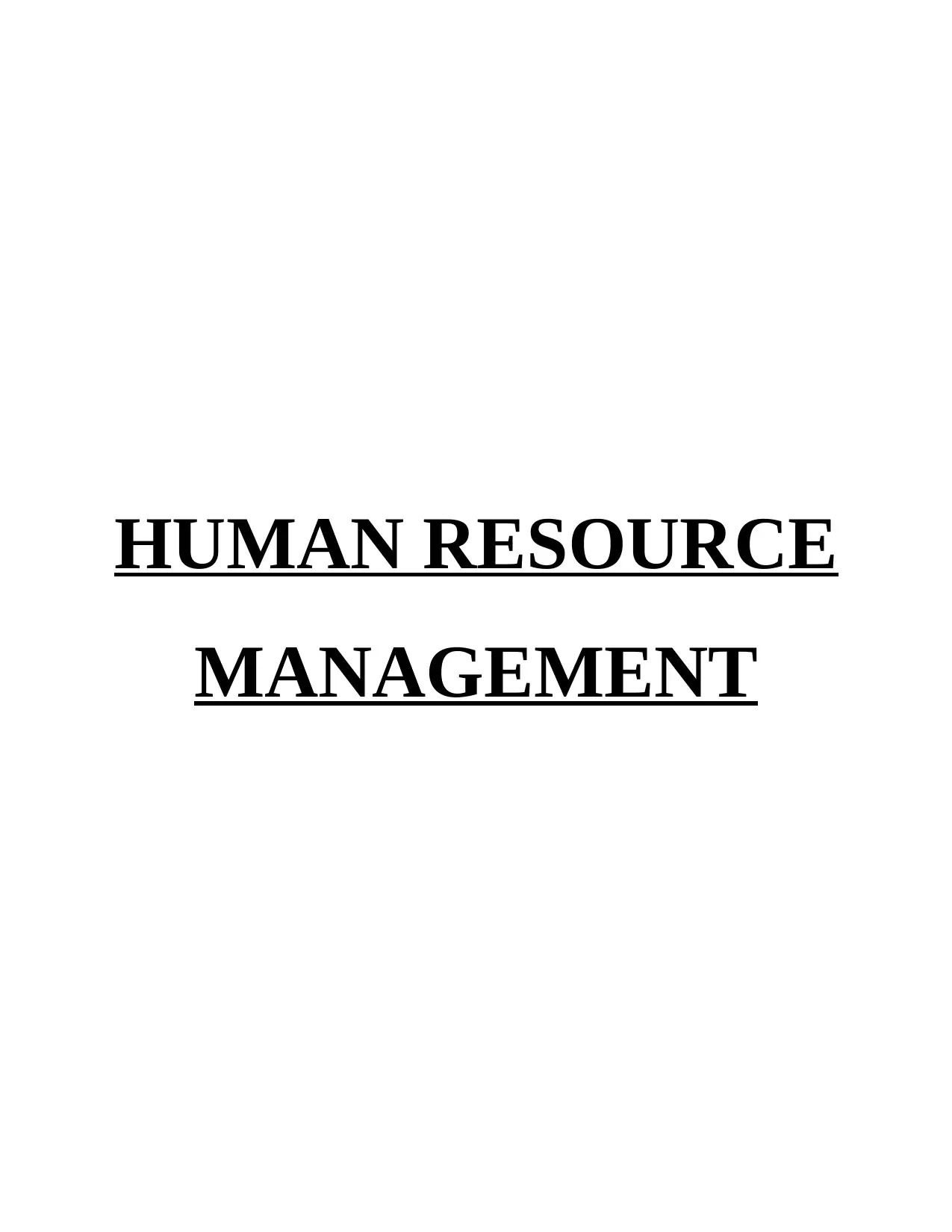
HUMAN RESOURCE
MANAGEMENT
MANAGEMENT
Paraphrase This Document
Need a fresh take? Get an instant paraphrase of this document with our AI Paraphraser
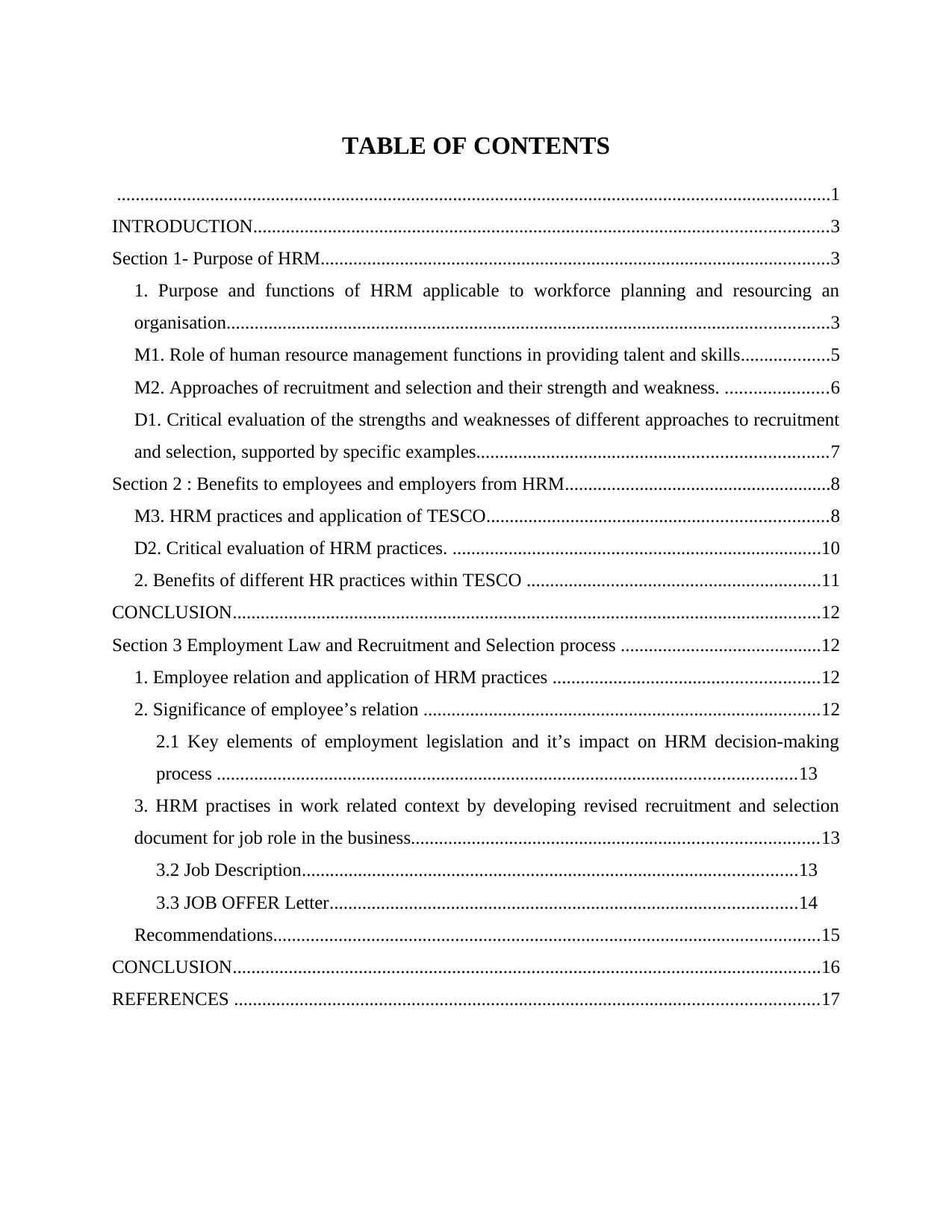
TABLE OF CONTENTS
.........................................................................................................................................................1
INTRODUCTION...........................................................................................................................3
Section 1- Purpose of HRM.............................................................................................................3
1. Purpose and functions of HRM applicable to workforce planning and resourcing an
organisation.................................................................................................................................3
M1. Role of human resource management functions in providing talent and skills...................5
M2. Approaches of recruitment and selection and their strength and weakness. ......................6
D1. Critical evaluation of the strengths and weaknesses of different approaches to recruitment
and selection, supported by specific examples...........................................................................7
Section 2 : Benefits to employees and employers from HRM.........................................................8
M3. HRM practices and application of TESCO.........................................................................8
D2. Critical evaluation of HRM practices. ...............................................................................10
2. Benefits of different HR practices within TESCO ...............................................................11
CONCLUSION..............................................................................................................................12
Section 3 Employment Law and Recruitment and Selection process ...........................................12
1. Employee relation and application of HRM practices .........................................................12
2. Significance of employee’s relation .....................................................................................12
2.1 Key elements of employment legislation and it’s impact on HRM decision-making
process ............................................................................................................................13
3. HRM practises in work related context by developing revised recruitment and selection
document for job role in the business.......................................................................................13
3.2 Job Description..........................................................................................................13
3.3 JOB OFFER Letter....................................................................................................14
Recommendations.....................................................................................................................15
CONCLUSION..............................................................................................................................16
REFERENCES .............................................................................................................................17
.........................................................................................................................................................1
INTRODUCTION...........................................................................................................................3
Section 1- Purpose of HRM.............................................................................................................3
1. Purpose and functions of HRM applicable to workforce planning and resourcing an
organisation.................................................................................................................................3
M1. Role of human resource management functions in providing talent and skills...................5
M2. Approaches of recruitment and selection and their strength and weakness. ......................6
D1. Critical evaluation of the strengths and weaknesses of different approaches to recruitment
and selection, supported by specific examples...........................................................................7
Section 2 : Benefits to employees and employers from HRM.........................................................8
M3. HRM practices and application of TESCO.........................................................................8
D2. Critical evaluation of HRM practices. ...............................................................................10
2. Benefits of different HR practices within TESCO ...............................................................11
CONCLUSION..............................................................................................................................12
Section 3 Employment Law and Recruitment and Selection process ...........................................12
1. Employee relation and application of HRM practices .........................................................12
2. Significance of employee’s relation .....................................................................................12
2.1 Key elements of employment legislation and it’s impact on HRM decision-making
process ............................................................................................................................13
3. HRM practises in work related context by developing revised recruitment and selection
document for job role in the business.......................................................................................13
3.2 Job Description..........................................................................................................13
3.3 JOB OFFER Letter....................................................................................................14
Recommendations.....................................................................................................................15
CONCLUSION..............................................................................................................................16
REFERENCES .............................................................................................................................17
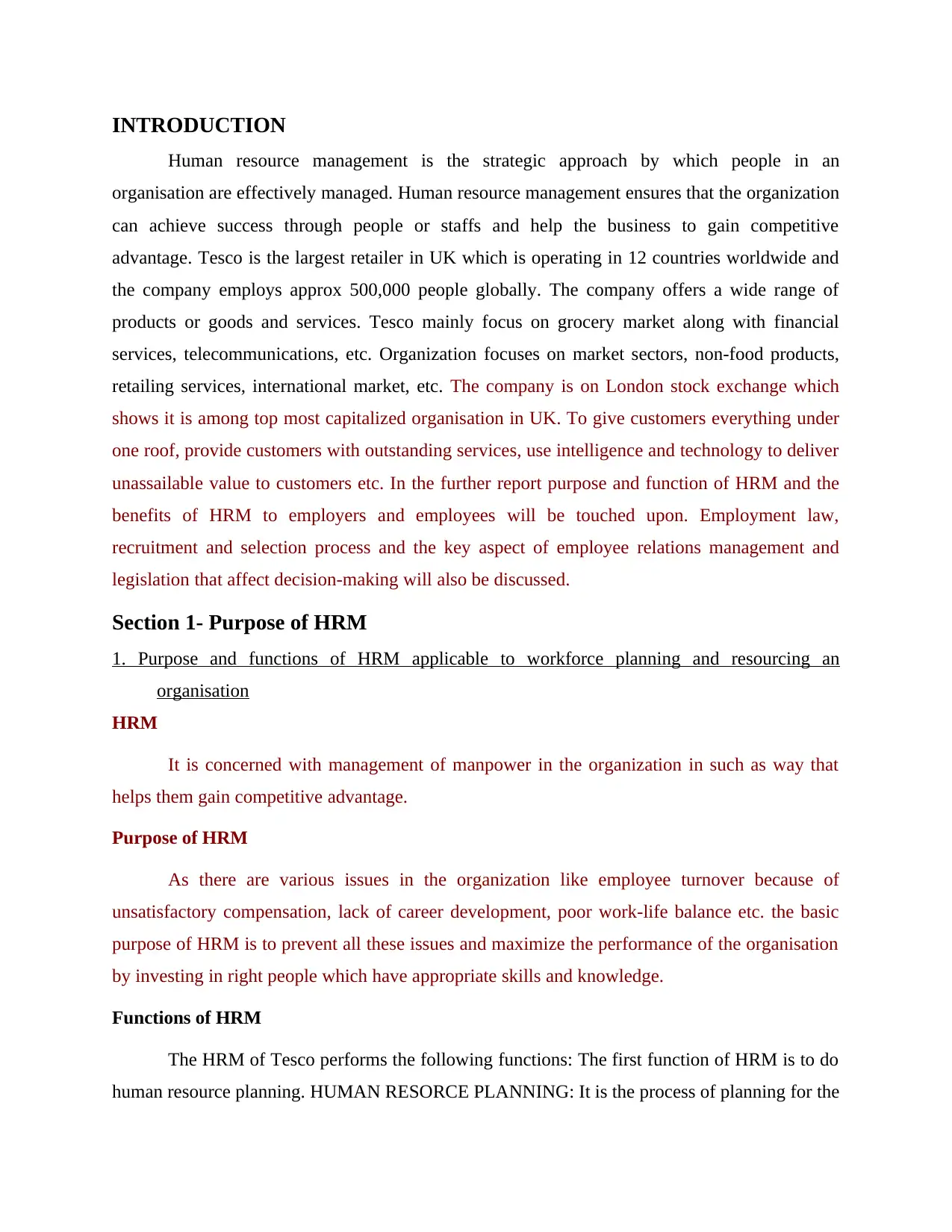
INTRODUCTION
Human resource management is the strategic approach by which people in an
organisation are effectively managed. Human resource management ensures that the organization
can achieve success through people or staffs and help the business to gain competitive
advantage. Tesco is the largest retailer in UK which is operating in 12 countries worldwide and
the company employs approx 500,000 people globally. The company offers a wide range of
products or goods and services. Tesco mainly focus on grocery market along with financial
services, telecommunications, etc. Organization focuses on market sectors, non-food products,
retailing services, international market, etc. The company is on London stock exchange which
shows it is among top most capitalized organisation in UK. To give customers everything under
one roof, provide customers with outstanding services, use intelligence and technology to deliver
unassailable value to customers etc. In the further report purpose and function of HRM and the
benefits of HRM to employers and employees will be touched upon. Employment law,
recruitment and selection process and the key aspect of employee relations management and
legislation that affect decision-making will also be discussed.
Section 1- Purpose of HRM
1. Purpose and functions of HRM applicable to workforce planning and resourcing an
organisation
HRM
It is concerned with management of manpower in the organization in such as way that
helps them gain competitive advantage.
Purpose of HRM
As there are various issues in the organization like employee turnover because of
unsatisfactory compensation, lack of career development, poor work-life balance etc. the basic
purpose of HRM is to prevent all these issues and maximize the performance of the organisation
by investing in right people which have appropriate skills and knowledge.
Functions of HRM
The HRM of Tesco performs the following functions: The first function of HRM is to do
human resource planning. HUMAN RESORCE PLANNING: It is the process of planning for the
Human resource management is the strategic approach by which people in an
organisation are effectively managed. Human resource management ensures that the organization
can achieve success through people or staffs and help the business to gain competitive
advantage. Tesco is the largest retailer in UK which is operating in 12 countries worldwide and
the company employs approx 500,000 people globally. The company offers a wide range of
products or goods and services. Tesco mainly focus on grocery market along with financial
services, telecommunications, etc. Organization focuses on market sectors, non-food products,
retailing services, international market, etc. The company is on London stock exchange which
shows it is among top most capitalized organisation in UK. To give customers everything under
one roof, provide customers with outstanding services, use intelligence and technology to deliver
unassailable value to customers etc. In the further report purpose and function of HRM and the
benefits of HRM to employers and employees will be touched upon. Employment law,
recruitment and selection process and the key aspect of employee relations management and
legislation that affect decision-making will also be discussed.
Section 1- Purpose of HRM
1. Purpose and functions of HRM applicable to workforce planning and resourcing an
organisation
HRM
It is concerned with management of manpower in the organization in such as way that
helps them gain competitive advantage.
Purpose of HRM
As there are various issues in the organization like employee turnover because of
unsatisfactory compensation, lack of career development, poor work-life balance etc. the basic
purpose of HRM is to prevent all these issues and maximize the performance of the organisation
by investing in right people which have appropriate skills and knowledge.
Functions of HRM
The HRM of Tesco performs the following functions: The first function of HRM is to do
human resource planning. HUMAN RESORCE PLANNING: It is the process of planning for the
⊘ This is a preview!⊘
Do you want full access?
Subscribe today to unlock all pages.

Trusted by 1+ million students worldwide
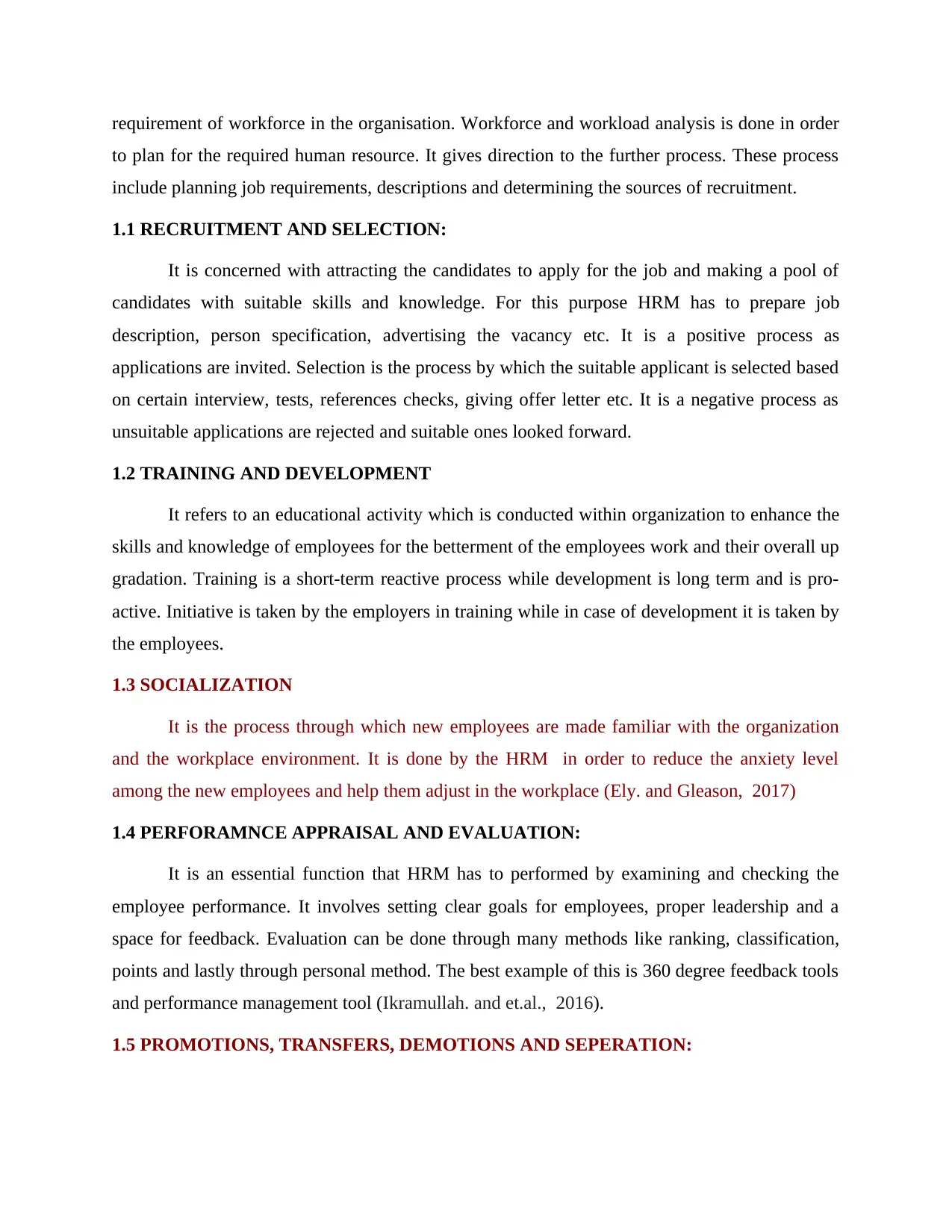
requirement of workforce in the organisation. Workforce and workload analysis is done in order
to plan for the required human resource. It gives direction to the further process. These process
include planning job requirements, descriptions and determining the sources of recruitment.
1.1 RECRUITMENT AND SELECTION:
It is concerned with attracting the candidates to apply for the job and making a pool of
candidates with suitable skills and knowledge. For this purpose HRM has to prepare job
description, person specification, advertising the vacancy etc. It is a positive process as
applications are invited. Selection is the process by which the suitable applicant is selected based
on certain interview, tests, references checks, giving offer letter etc. It is a negative process as
unsuitable applications are rejected and suitable ones looked forward.
1.2 TRAINING AND DEVELOPMENT
It refers to an educational activity which is conducted within organization to enhance the
skills and knowledge of employees for the betterment of the employees work and their overall up
gradation. Training is a short-term reactive process while development is long term and is pro-
active. Initiative is taken by the employers in training while in case of development it is taken by
the employees.
1.3 SOCIALIZATION
It is the process through which new employees are made familiar with the organization
and the workplace environment. It is done by the HRM in order to reduce the anxiety level
among the new employees and help them adjust in the workplace (Ely. and Gleason, 2017)
1.4 PERFORAMNCE APPRAISAL AND EVALUATION:
It is an essential function that HRM has to performed by examining and checking the
employee performance. It involves setting clear goals for employees, proper leadership and a
space for feedback. Evaluation can be done through many methods like ranking, classification,
points and lastly through personal method. The best example of this is 360 degree feedback tools
and performance management tool (Ikramullah. and et.al., 2016).
1.5 PROMOTIONS, TRANSFERS, DEMOTIONS AND SEPERATION:
to plan for the required human resource. It gives direction to the further process. These process
include planning job requirements, descriptions and determining the sources of recruitment.
1.1 RECRUITMENT AND SELECTION:
It is concerned with attracting the candidates to apply for the job and making a pool of
candidates with suitable skills and knowledge. For this purpose HRM has to prepare job
description, person specification, advertising the vacancy etc. It is a positive process as
applications are invited. Selection is the process by which the suitable applicant is selected based
on certain interview, tests, references checks, giving offer letter etc. It is a negative process as
unsuitable applications are rejected and suitable ones looked forward.
1.2 TRAINING AND DEVELOPMENT
It refers to an educational activity which is conducted within organization to enhance the
skills and knowledge of employees for the betterment of the employees work and their overall up
gradation. Training is a short-term reactive process while development is long term and is pro-
active. Initiative is taken by the employers in training while in case of development it is taken by
the employees.
1.3 SOCIALIZATION
It is the process through which new employees are made familiar with the organization
and the workplace environment. It is done by the HRM in order to reduce the anxiety level
among the new employees and help them adjust in the workplace (Ely. and Gleason, 2017)
1.4 PERFORAMNCE APPRAISAL AND EVALUATION:
It is an essential function that HRM has to performed by examining and checking the
employee performance. It involves setting clear goals for employees, proper leadership and a
space for feedback. Evaluation can be done through many methods like ranking, classification,
points and lastly through personal method. The best example of this is 360 degree feedback tools
and performance management tool (Ikramullah. and et.al., 2016).
1.5 PROMOTIONS, TRANSFERS, DEMOTIONS AND SEPERATION:
Paraphrase This Document
Need a fresh take? Get an instant paraphrase of this document with our AI Paraphraser
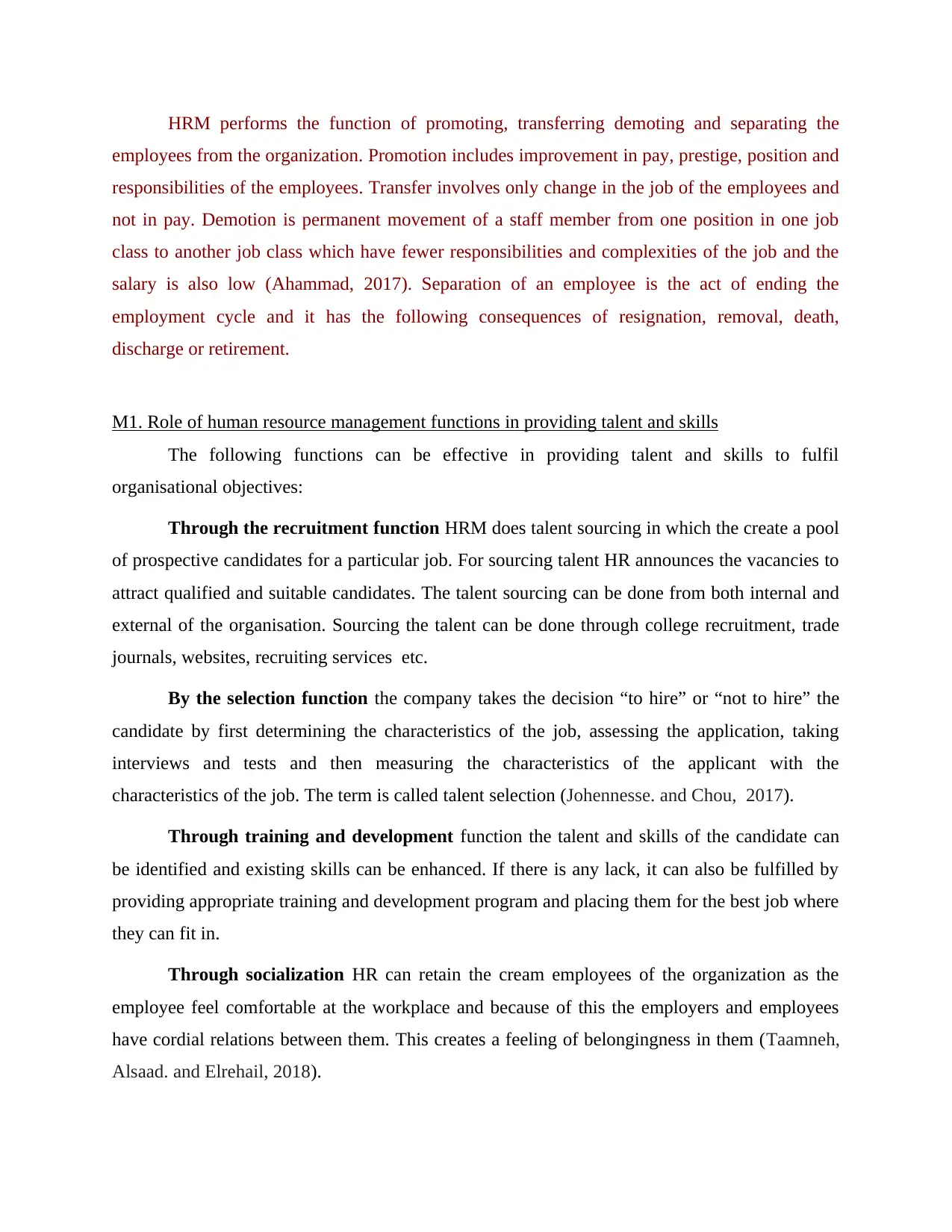
HRM performs the function of promoting, transferring demoting and separating the
employees from the organization. Promotion includes improvement in pay, prestige, position and
responsibilities of the employees. Transfer involves only change in the job of the employees and
not in pay. Demotion is permanent movement of a staff member from one position in one job
class to another job class which have fewer responsibilities and complexities of the job and the
salary is also low (Ahammad, 2017). Separation of an employee is the act of ending the
employment cycle and it has the following consequences of resignation, removal, death,
discharge or retirement.
M1. Role of human resource management functions in providing talent and skills
The following functions can be effective in providing talent and skills to fulfil
organisational objectives:
Through the recruitment function HRM does talent sourcing in which the create a pool
of prospective candidates for a particular job. For sourcing talent HR announces the vacancies to
attract qualified and suitable candidates. The talent sourcing can be done from both internal and
external of the organisation. Sourcing the talent can be done through college recruitment, trade
journals, websites, recruiting services etc.
By the selection function the company takes the decision “to hire” or “not to hire” the
candidate by first determining the characteristics of the job, assessing the application, taking
interviews and tests and then measuring the characteristics of the applicant with the
characteristics of the job. The term is called talent selection (Johennesse. and Chou, 2017).
Through training and development function the talent and skills of the candidate can
be identified and existing skills can be enhanced. If there is any lack, it can also be fulfilled by
providing appropriate training and development program and placing them for the best job where
they can fit in.
Through socialization HR can retain the cream employees of the organization as the
employee feel comfortable at the workplace and because of this the employers and employees
have cordial relations between them. This creates a feeling of belongingness in them (Taamneh,
Alsaad. and Elrehail, 2018).
employees from the organization. Promotion includes improvement in pay, prestige, position and
responsibilities of the employees. Transfer involves only change in the job of the employees and
not in pay. Demotion is permanent movement of a staff member from one position in one job
class to another job class which have fewer responsibilities and complexities of the job and the
salary is also low (Ahammad, 2017). Separation of an employee is the act of ending the
employment cycle and it has the following consequences of resignation, removal, death,
discharge or retirement.
M1. Role of human resource management functions in providing talent and skills
The following functions can be effective in providing talent and skills to fulfil
organisational objectives:
Through the recruitment function HRM does talent sourcing in which the create a pool
of prospective candidates for a particular job. For sourcing talent HR announces the vacancies to
attract qualified and suitable candidates. The talent sourcing can be done from both internal and
external of the organisation. Sourcing the talent can be done through college recruitment, trade
journals, websites, recruiting services etc.
By the selection function the company takes the decision “to hire” or “not to hire” the
candidate by first determining the characteristics of the job, assessing the application, taking
interviews and tests and then measuring the characteristics of the applicant with the
characteristics of the job. The term is called talent selection (Johennesse. and Chou, 2017).
Through training and development function the talent and skills of the candidate can
be identified and existing skills can be enhanced. If there is any lack, it can also be fulfilled by
providing appropriate training and development program and placing them for the best job where
they can fit in.
Through socialization HR can retain the cream employees of the organization as the
employee feel comfortable at the workplace and because of this the employers and employees
have cordial relations between them. This creates a feeling of belongingness in them (Taamneh,
Alsaad. and Elrehail, 2018).
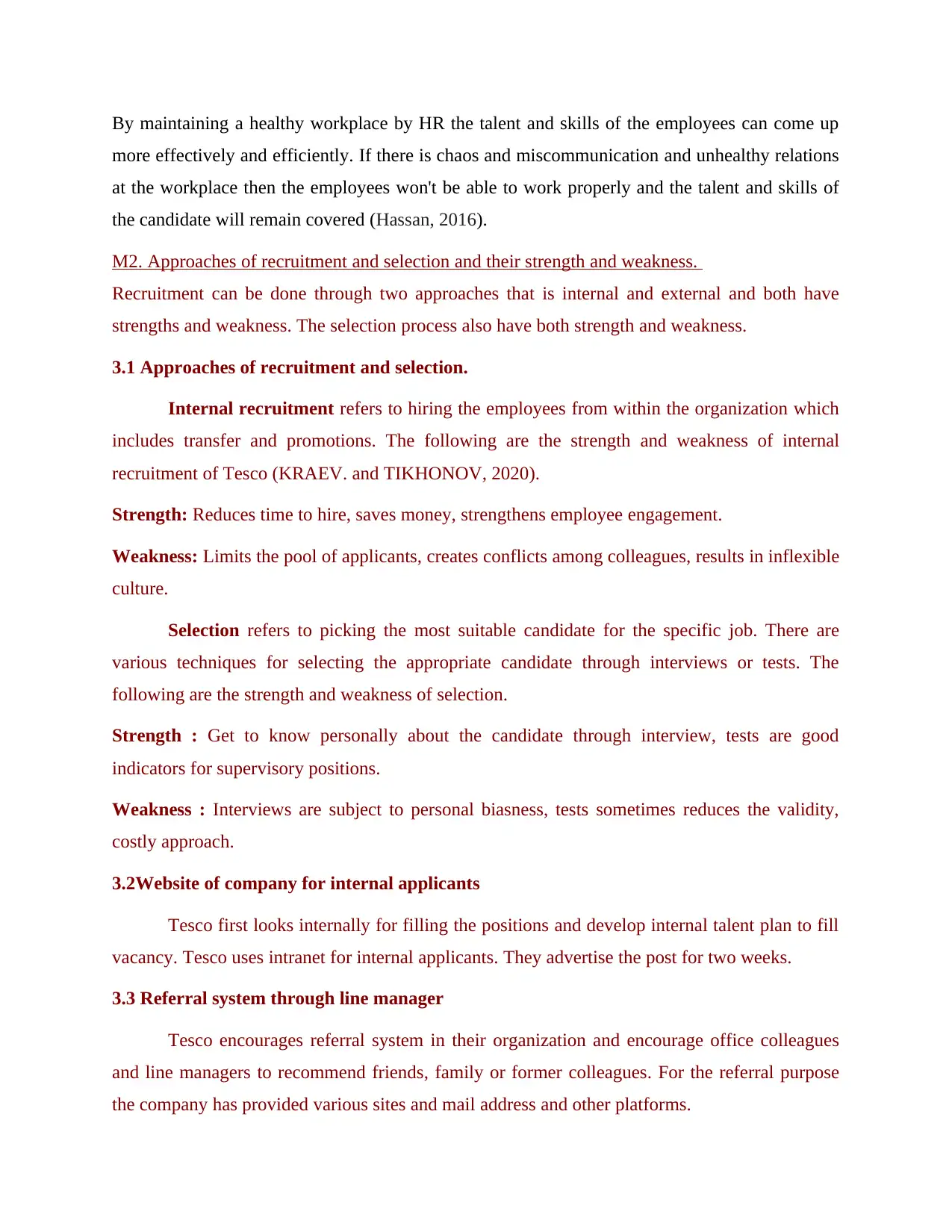
By maintaining a healthy workplace by HR the talent and skills of the employees can come up
more effectively and efficiently. If there is chaos and miscommunication and unhealthy relations
at the workplace then the employees won't be able to work properly and the talent and skills of
the candidate will remain covered (Hassan, 2016).
M2. Approaches of recruitment and selection and their strength and weakness.
Recruitment can be done through two approaches that is internal and external and both have
strengths and weakness. The selection process also have both strength and weakness.
3.1 Approaches of recruitment and selection.
Internal recruitment refers to hiring the employees from within the organization which
includes transfer and promotions. The following are the strength and weakness of internal
recruitment of Tesco (KRAEV. and TIKHONOV, 2020).
Strength: Reduces time to hire, saves money, strengthens employee engagement.
Weakness: Limits the pool of applicants, creates conflicts among colleagues, results in inflexible
culture.
Selection refers to picking the most suitable candidate for the specific job. There are
various techniques for selecting the appropriate candidate through interviews or tests. The
following are the strength and weakness of selection.
Strength : Get to know personally about the candidate through interview, tests are good
indicators for supervisory positions.
Weakness : Interviews are subject to personal biasness, tests sometimes reduces the validity,
costly approach.
3.2Website of company for internal applicants
Tesco first looks internally for filling the positions and develop internal talent plan to fill
vacancy. Tesco uses intranet for internal applicants. They advertise the post for two weeks.
3.3 Referral system through line manager
Tesco encourages referral system in their organization and encourage office colleagues
and line managers to recommend friends, family or former colleagues. For the referral purpose
the company has provided various sites and mail address and other platforms.
more effectively and efficiently. If there is chaos and miscommunication and unhealthy relations
at the workplace then the employees won't be able to work properly and the talent and skills of
the candidate will remain covered (Hassan, 2016).
M2. Approaches of recruitment and selection and their strength and weakness.
Recruitment can be done through two approaches that is internal and external and both have
strengths and weakness. The selection process also have both strength and weakness.
3.1 Approaches of recruitment and selection.
Internal recruitment refers to hiring the employees from within the organization which
includes transfer and promotions. The following are the strength and weakness of internal
recruitment of Tesco (KRAEV. and TIKHONOV, 2020).
Strength: Reduces time to hire, saves money, strengthens employee engagement.
Weakness: Limits the pool of applicants, creates conflicts among colleagues, results in inflexible
culture.
Selection refers to picking the most suitable candidate for the specific job. There are
various techniques for selecting the appropriate candidate through interviews or tests. The
following are the strength and weakness of selection.
Strength : Get to know personally about the candidate through interview, tests are good
indicators for supervisory positions.
Weakness : Interviews are subject to personal biasness, tests sometimes reduces the validity,
costly approach.
3.2Website of company for internal applicants
Tesco first looks internally for filling the positions and develop internal talent plan to fill
vacancy. Tesco uses intranet for internal applicants. They advertise the post for two weeks.
3.3 Referral system through line manager
Tesco encourages referral system in their organization and encourage office colleagues
and line managers to recommend friends, family or former colleagues. For the referral purpose
the company has provided various sites and mail address and other platforms.
⊘ This is a preview!⊘
Do you want full access?
Subscribe today to unlock all pages.

Trusted by 1+ million students worldwide
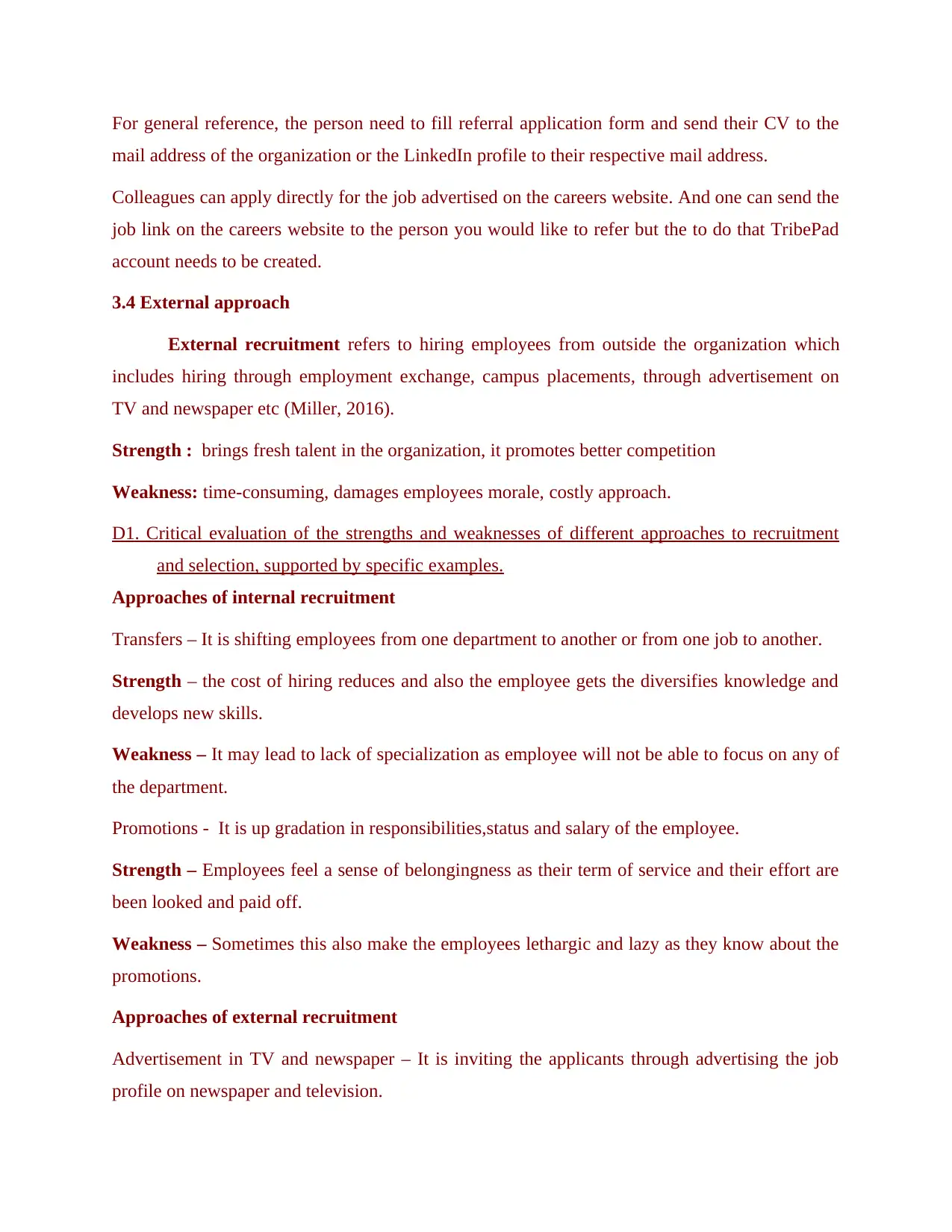
For general reference, the person need to fill referral application form and send their CV to the
mail address of the organization or the LinkedIn profile to their respective mail address.
Colleagues can apply directly for the job advertised on the careers website. And one can send the
job link on the careers website to the person you would like to refer but the to do that TribePad
account needs to be created.
3.4 External approach
External recruitment refers to hiring employees from outside the organization which
includes hiring through employment exchange, campus placements, through advertisement on
TV and newspaper etc (Miller, 2016).
Strength : brings fresh talent in the organization, it promotes better competition
Weakness: time-consuming, damages employees morale, costly approach.
D1. Critical evaluation of the strengths and weaknesses of different approaches to recruitment
and selection, supported by specific examples.
Approaches of internal recruitment
Transfers – It is shifting employees from one department to another or from one job to another.
Strength – the cost of hiring reduces and also the employee gets the diversifies knowledge and
develops new skills.
Weakness – It may lead to lack of specialization as employee will not be able to focus on any of
the department.
Promotions - It is up gradation in responsibilities,status and salary of the employee.
Strength – Employees feel a sense of belongingness as their term of service and their effort are
been looked and paid off.
Weakness – Sometimes this also make the employees lethargic and lazy as they know about the
promotions.
Approaches of external recruitment
Advertisement in TV and newspaper – It is inviting the applicants through advertising the job
profile on newspaper and television.
mail address of the organization or the LinkedIn profile to their respective mail address.
Colleagues can apply directly for the job advertised on the careers website. And one can send the
job link on the careers website to the person you would like to refer but the to do that TribePad
account needs to be created.
3.4 External approach
External recruitment refers to hiring employees from outside the organization which
includes hiring through employment exchange, campus placements, through advertisement on
TV and newspaper etc (Miller, 2016).
Strength : brings fresh talent in the organization, it promotes better competition
Weakness: time-consuming, damages employees morale, costly approach.
D1. Critical evaluation of the strengths and weaknesses of different approaches to recruitment
and selection, supported by specific examples.
Approaches of internal recruitment
Transfers – It is shifting employees from one department to another or from one job to another.
Strength – the cost of hiring reduces and also the employee gets the diversifies knowledge and
develops new skills.
Weakness – It may lead to lack of specialization as employee will not be able to focus on any of
the department.
Promotions - It is up gradation in responsibilities,status and salary of the employee.
Strength – Employees feel a sense of belongingness as their term of service and their effort are
been looked and paid off.
Weakness – Sometimes this also make the employees lethargic and lazy as they know about the
promotions.
Approaches of external recruitment
Advertisement in TV and newspaper – It is inviting the applicants through advertising the job
profile on newspaper and television.
Paraphrase This Document
Need a fresh take? Get an instant paraphrase of this document with our AI Paraphraser
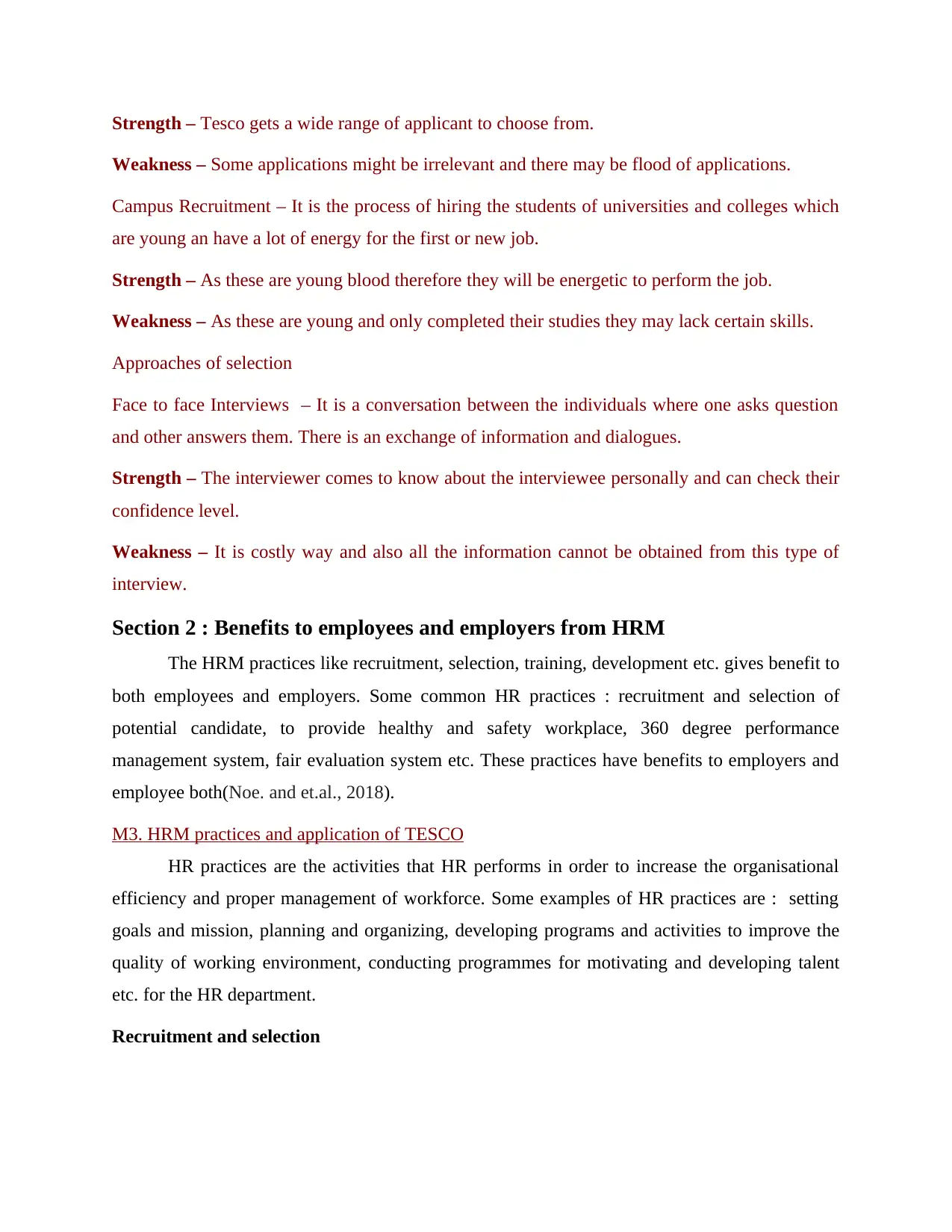
Strength – Tesco gets a wide range of applicant to choose from.
Weakness – Some applications might be irrelevant and there may be flood of applications.
Campus Recruitment – It is the process of hiring the students of universities and colleges which
are young an have a lot of energy for the first or new job.
Strength – As these are young blood therefore they will be energetic to perform the job.
Weakness – As these are young and only completed their studies they may lack certain skills.
Approaches of selection
Face to face Interviews – It is a conversation between the individuals where one asks question
and other answers them. There is an exchange of information and dialogues.
Strength – The interviewer comes to know about the interviewee personally and can check their
confidence level.
Weakness – It is costly way and also all the information cannot be obtained from this type of
interview.
Section 2 : Benefits to employees and employers from HRM
The HRM practices like recruitment, selection, training, development etc. gives benefit to
both employees and employers. Some common HR practices : recruitment and selection of
potential candidate, to provide healthy and safety workplace, 360 degree performance
management system, fair evaluation system etc. These practices have benefits to employers and
employee both(Noe. and et.al., 2018).
M3. HRM practices and application of TESCO
HR practices are the activities that HR performs in order to increase the organisational
efficiency and proper management of workforce. Some examples of HR practices are : setting
goals and mission, planning and organizing, developing programs and activities to improve the
quality of working environment, conducting programmes for motivating and developing talent
etc. for the HR department.
Recruitment and selection
Weakness – Some applications might be irrelevant and there may be flood of applications.
Campus Recruitment – It is the process of hiring the students of universities and colleges which
are young an have a lot of energy for the first or new job.
Strength – As these are young blood therefore they will be energetic to perform the job.
Weakness – As these are young and only completed their studies they may lack certain skills.
Approaches of selection
Face to face Interviews – It is a conversation between the individuals where one asks question
and other answers them. There is an exchange of information and dialogues.
Strength – The interviewer comes to know about the interviewee personally and can check their
confidence level.
Weakness – It is costly way and also all the information cannot be obtained from this type of
interview.
Section 2 : Benefits to employees and employers from HRM
The HRM practices like recruitment, selection, training, development etc. gives benefit to
both employees and employers. Some common HR practices : recruitment and selection of
potential candidate, to provide healthy and safety workplace, 360 degree performance
management system, fair evaluation system etc. These practices have benefits to employers and
employee both(Noe. and et.al., 2018).
M3. HRM practices and application of TESCO
HR practices are the activities that HR performs in order to increase the organisational
efficiency and proper management of workforce. Some examples of HR practices are : setting
goals and mission, planning and organizing, developing programs and activities to improve the
quality of working environment, conducting programmes for motivating and developing talent
etc. for the HR department.
Recruitment and selection
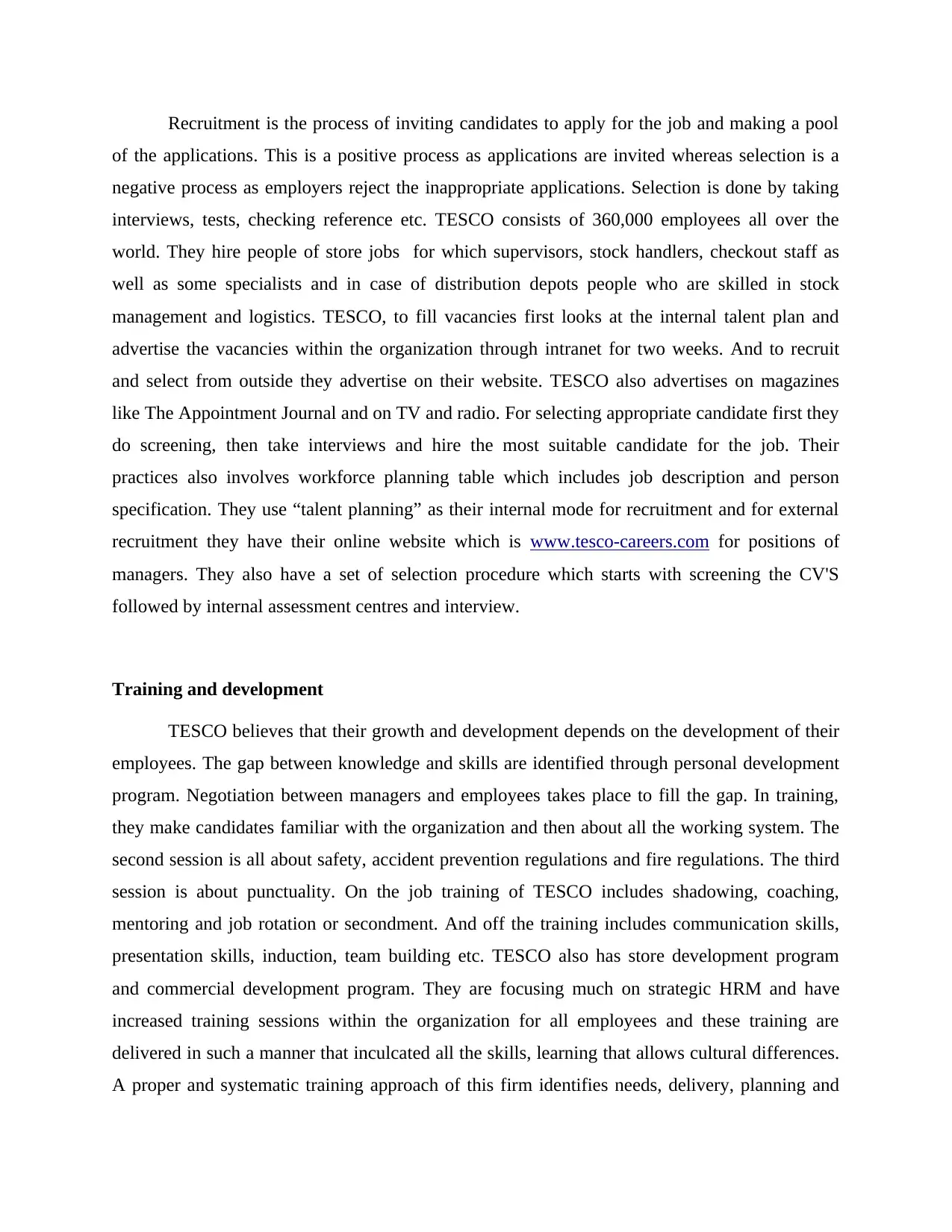
Recruitment is the process of inviting candidates to apply for the job and making a pool
of the applications. This is a positive process as applications are invited whereas selection is a
negative process as employers reject the inappropriate applications. Selection is done by taking
interviews, tests, checking reference etc. TESCO consists of 360,000 employees all over the
world. They hire people of store jobs for which supervisors, stock handlers, checkout staff as
well as some specialists and in case of distribution depots people who are skilled in stock
management and logistics. TESCO, to fill vacancies first looks at the internal talent plan and
advertise the vacancies within the organization through intranet for two weeks. And to recruit
and select from outside they advertise on their website. TESCO also advertises on magazines
like The Appointment Journal and on TV and radio. For selecting appropriate candidate first they
do screening, then take interviews and hire the most suitable candidate for the job. Their
practices also involves workforce planning table which includes job description and person
specification. They use “talent planning” as their internal mode for recruitment and for external
recruitment they have their online website which is www.tesco-careers.com for positions of
managers. They also have a set of selection procedure which starts with screening the CV'S
followed by internal assessment centres and interview.
Training and development
TESCO believes that their growth and development depends on the development of their
employees. The gap between knowledge and skills are identified through personal development
program. Negotiation between managers and employees takes place to fill the gap. In training,
they make candidates familiar with the organization and then about all the working system. The
second session is all about safety, accident prevention regulations and fire regulations. The third
session is about punctuality. On the job training of TESCO includes shadowing, coaching,
mentoring and job rotation or secondment. And off the training includes communication skills,
presentation skills, induction, team building etc. TESCO also has store development program
and commercial development program. They are focusing much on strategic HRM and have
increased training sessions within the organization for all employees and these training are
delivered in such a manner that inculcated all the skills, learning that allows cultural differences.
A proper and systematic training approach of this firm identifies needs, delivery, planning and
of the applications. This is a positive process as applications are invited whereas selection is a
negative process as employers reject the inappropriate applications. Selection is done by taking
interviews, tests, checking reference etc. TESCO consists of 360,000 employees all over the
world. They hire people of store jobs for which supervisors, stock handlers, checkout staff as
well as some specialists and in case of distribution depots people who are skilled in stock
management and logistics. TESCO, to fill vacancies first looks at the internal talent plan and
advertise the vacancies within the organization through intranet for two weeks. And to recruit
and select from outside they advertise on their website. TESCO also advertises on magazines
like The Appointment Journal and on TV and radio. For selecting appropriate candidate first they
do screening, then take interviews and hire the most suitable candidate for the job. Their
practices also involves workforce planning table which includes job description and person
specification. They use “talent planning” as their internal mode for recruitment and for external
recruitment they have their online website which is www.tesco-careers.com for positions of
managers. They also have a set of selection procedure which starts with screening the CV'S
followed by internal assessment centres and interview.
Training and development
TESCO believes that their growth and development depends on the development of their
employees. The gap between knowledge and skills are identified through personal development
program. Negotiation between managers and employees takes place to fill the gap. In training,
they make candidates familiar with the organization and then about all the working system. The
second session is all about safety, accident prevention regulations and fire regulations. The third
session is about punctuality. On the job training of TESCO includes shadowing, coaching,
mentoring and job rotation or secondment. And off the training includes communication skills,
presentation skills, induction, team building etc. TESCO also has store development program
and commercial development program. They are focusing much on strategic HRM and have
increased training sessions within the organization for all employees and these training are
delivered in such a manner that inculcated all the skills, learning that allows cultural differences.
A proper and systematic training approach of this firm identifies needs, delivery, planning and
⊘ This is a preview!⊘
Do you want full access?
Subscribe today to unlock all pages.

Trusted by 1+ million students worldwide
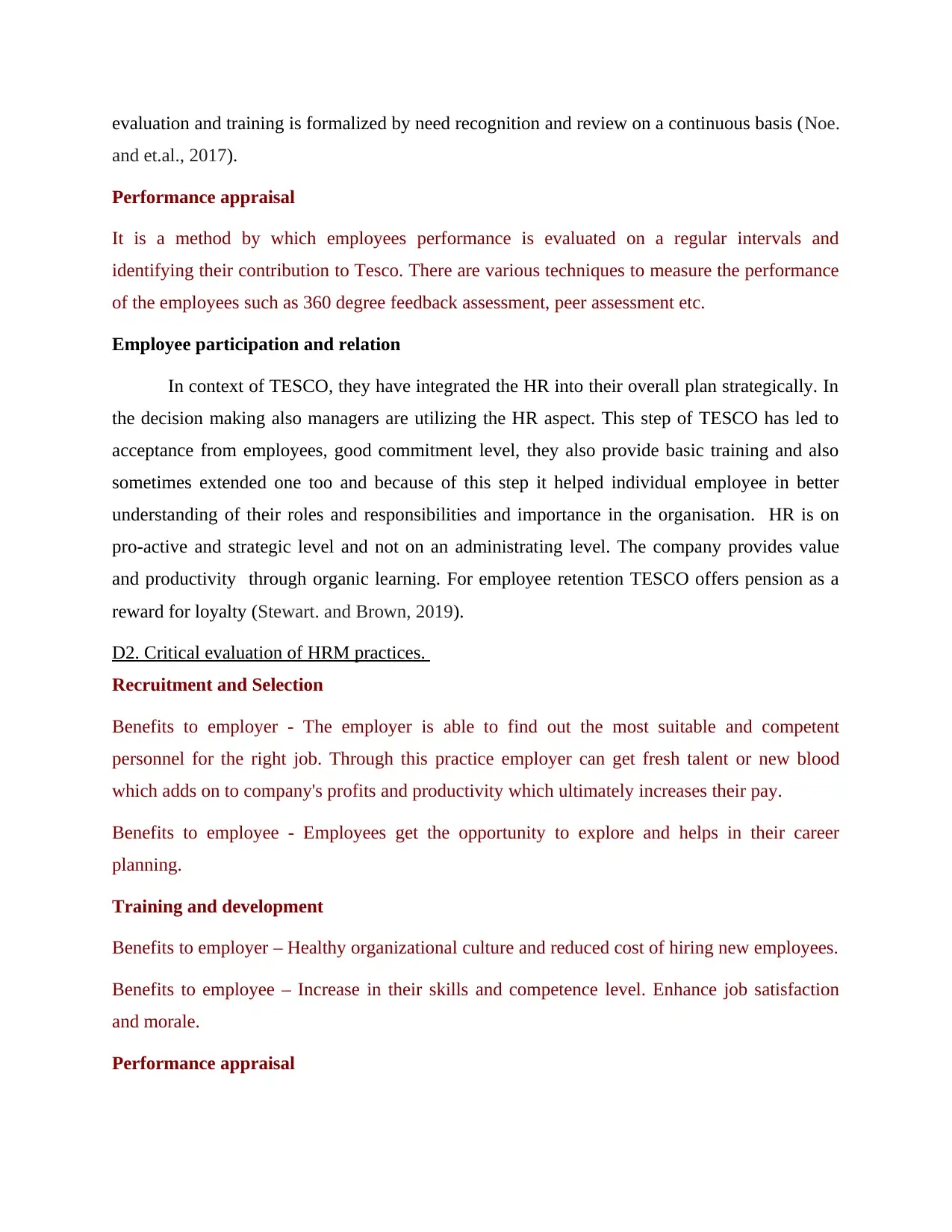
evaluation and training is formalized by need recognition and review on a continuous basis (Noe.
and et.al., 2017).
Performance appraisal
It is a method by which employees performance is evaluated on a regular intervals and
identifying their contribution to Tesco. There are various techniques to measure the performance
of the employees such as 360 degree feedback assessment, peer assessment etc.
Employee participation and relation
In context of TESCO, they have integrated the HR into their overall plan strategically. In
the decision making also managers are utilizing the HR aspect. This step of TESCO has led to
acceptance from employees, good commitment level, they also provide basic training and also
sometimes extended one too and because of this step it helped individual employee in better
understanding of their roles and responsibilities and importance in the organisation. HR is on
pro-active and strategic level and not on an administrating level. The company provides value
and productivity through organic learning. For employee retention TESCO offers pension as a
reward for loyalty (Stewart. and Brown, 2019).
D2. Critical evaluation of HRM practices.
Recruitment and Selection
Benefits to employer - The employer is able to find out the most suitable and competent
personnel for the right job. Through this practice employer can get fresh talent or new blood
which adds on to company's profits and productivity which ultimately increases their pay.
Benefits to employee - Employees get the opportunity to explore and helps in their career
planning.
Training and development
Benefits to employer – Healthy organizational culture and reduced cost of hiring new employees.
Benefits to employee – Increase in their skills and competence level. Enhance job satisfaction
and morale.
Performance appraisal
and et.al., 2017).
Performance appraisal
It is a method by which employees performance is evaluated on a regular intervals and
identifying their contribution to Tesco. There are various techniques to measure the performance
of the employees such as 360 degree feedback assessment, peer assessment etc.
Employee participation and relation
In context of TESCO, they have integrated the HR into their overall plan strategically. In
the decision making also managers are utilizing the HR aspect. This step of TESCO has led to
acceptance from employees, good commitment level, they also provide basic training and also
sometimes extended one too and because of this step it helped individual employee in better
understanding of their roles and responsibilities and importance in the organisation. HR is on
pro-active and strategic level and not on an administrating level. The company provides value
and productivity through organic learning. For employee retention TESCO offers pension as a
reward for loyalty (Stewart. and Brown, 2019).
D2. Critical evaluation of HRM practices.
Recruitment and Selection
Benefits to employer - The employer is able to find out the most suitable and competent
personnel for the right job. Through this practice employer can get fresh talent or new blood
which adds on to company's profits and productivity which ultimately increases their pay.
Benefits to employee - Employees get the opportunity to explore and helps in their career
planning.
Training and development
Benefits to employer – Healthy organizational culture and reduced cost of hiring new employees.
Benefits to employee – Increase in their skills and competence level. Enhance job satisfaction
and morale.
Performance appraisal
Paraphrase This Document
Need a fresh take? Get an instant paraphrase of this document with our AI Paraphraser
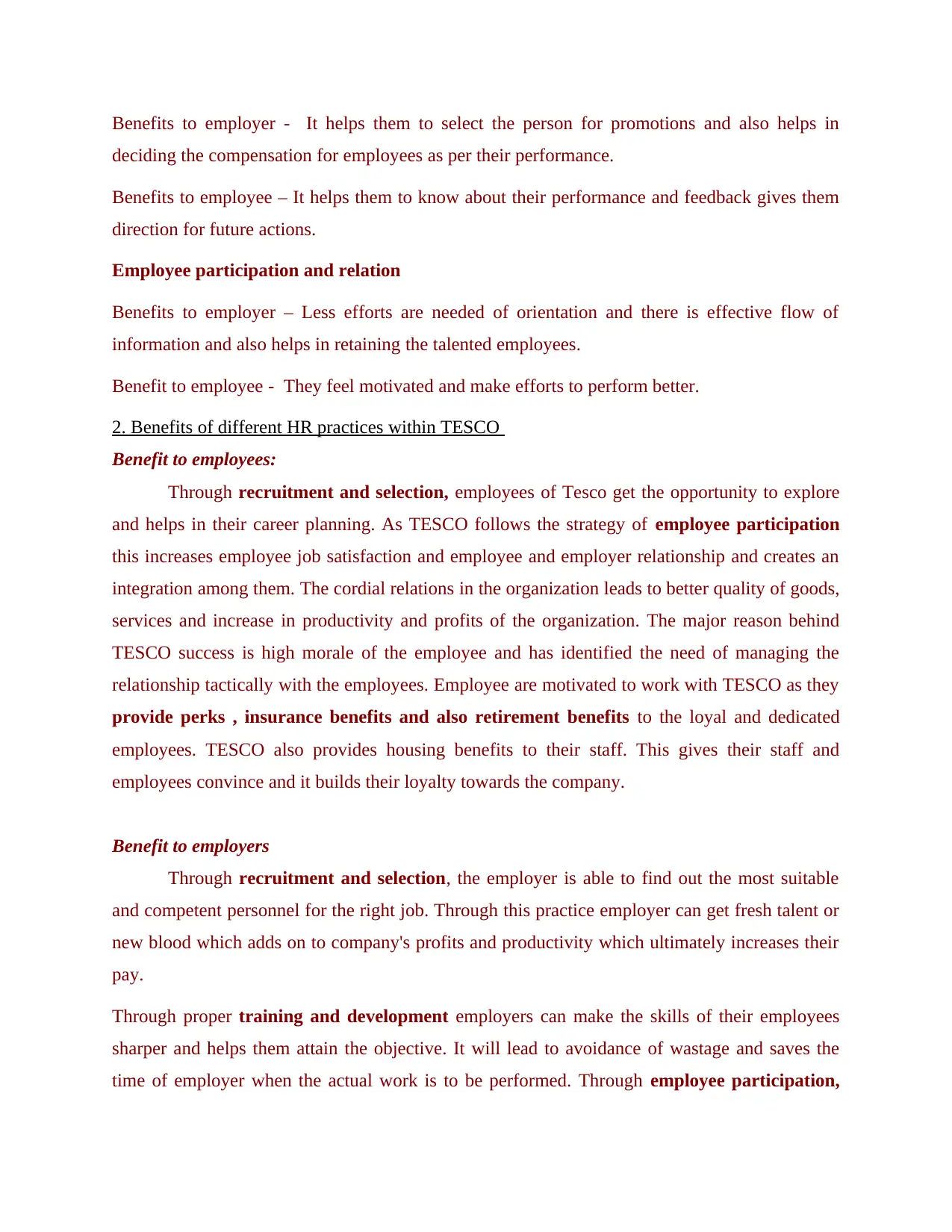
Benefits to employer - It helps them to select the person for promotions and also helps in
deciding the compensation for employees as per their performance.
Benefits to employee – It helps them to know about their performance and feedback gives them
direction for future actions.
Employee participation and relation
Benefits to employer – Less efforts are needed of orientation and there is effective flow of
information and also helps in retaining the talented employees.
Benefit to employee - They feel motivated and make efforts to perform better.
2. Benefits of different HR practices within TESCO
Benefit to employees:
Through recruitment and selection, employees of Tesco get the opportunity to explore
and helps in their career planning. As TESCO follows the strategy of employee participation
this increases employee job satisfaction and employee and employer relationship and creates an
integration among them. The cordial relations in the organization leads to better quality of goods,
services and increase in productivity and profits of the organization. The major reason behind
TESCO success is high morale of the employee and has identified the need of managing the
relationship tactically with the employees. Employee are motivated to work with TESCO as they
provide perks , insurance benefits and also retirement benefits to the loyal and dedicated
employees. TESCO also provides housing benefits to their staff. This gives their staff and
employees convince and it builds their loyalty towards the company.
Benefit to employers
Through recruitment and selection, the employer is able to find out the most suitable
and competent personnel for the right job. Through this practice employer can get fresh talent or
new blood which adds on to company's profits and productivity which ultimately increases their
pay.
Through proper training and development employers can make the skills of their employees
sharper and helps them attain the objective. It will lead to avoidance of wastage and saves the
time of employer when the actual work is to be performed. Through employee participation,
deciding the compensation for employees as per their performance.
Benefits to employee – It helps them to know about their performance and feedback gives them
direction for future actions.
Employee participation and relation
Benefits to employer – Less efforts are needed of orientation and there is effective flow of
information and also helps in retaining the talented employees.
Benefit to employee - They feel motivated and make efforts to perform better.
2. Benefits of different HR practices within TESCO
Benefit to employees:
Through recruitment and selection, employees of Tesco get the opportunity to explore
and helps in their career planning. As TESCO follows the strategy of employee participation
this increases employee job satisfaction and employee and employer relationship and creates an
integration among them. The cordial relations in the organization leads to better quality of goods,
services and increase in productivity and profits of the organization. The major reason behind
TESCO success is high morale of the employee and has identified the need of managing the
relationship tactically with the employees. Employee are motivated to work with TESCO as they
provide perks , insurance benefits and also retirement benefits to the loyal and dedicated
employees. TESCO also provides housing benefits to their staff. This gives their staff and
employees convince and it builds their loyalty towards the company.
Benefit to employers
Through recruitment and selection, the employer is able to find out the most suitable
and competent personnel for the right job. Through this practice employer can get fresh talent or
new blood which adds on to company's profits and productivity which ultimately increases their
pay.
Through proper training and development employers can make the skills of their employees
sharper and helps them attain the objective. It will lead to avoidance of wastage and saves the
time of employer when the actual work is to be performed. Through employee participation,
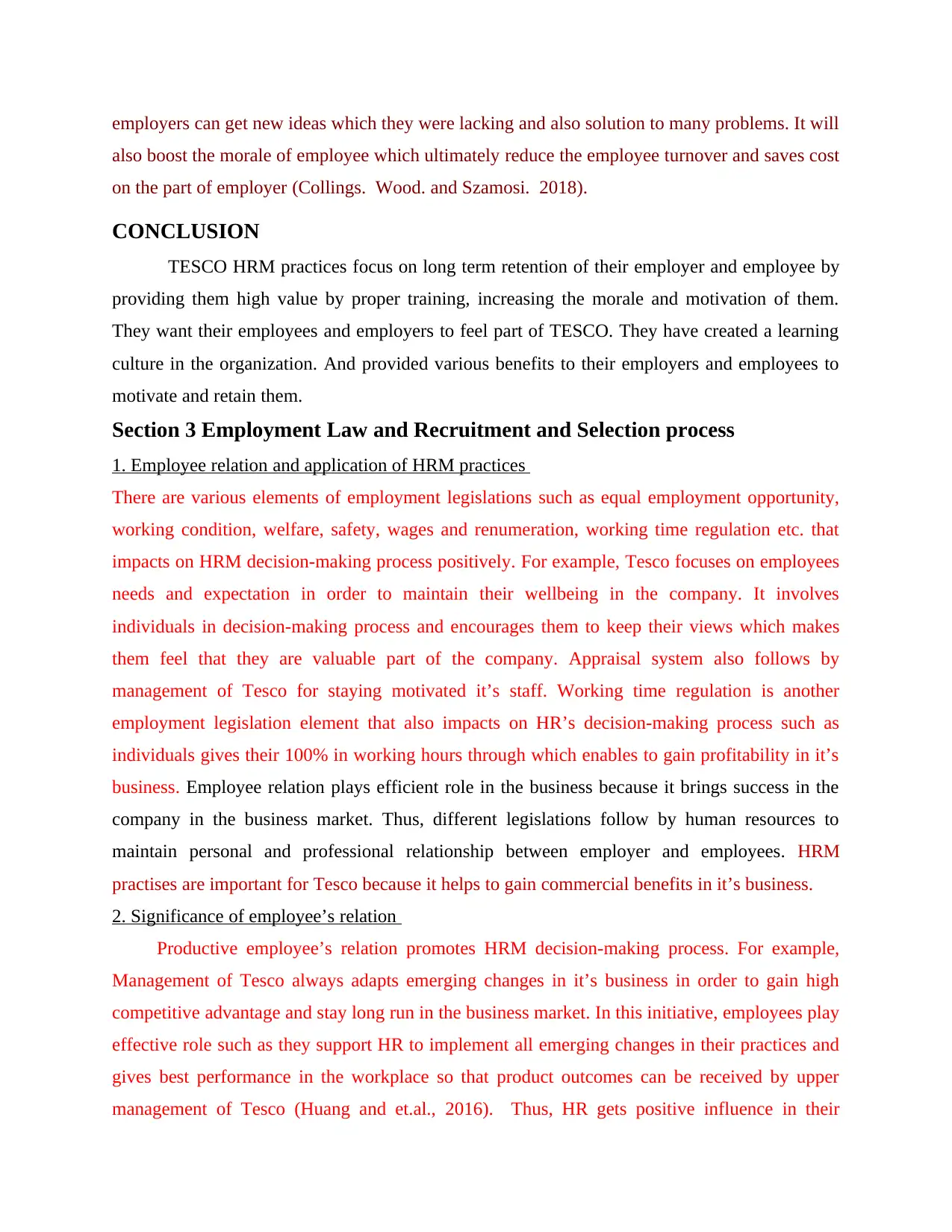
employers can get new ideas which they were lacking and also solution to many problems. It will
also boost the morale of employee which ultimately reduce the employee turnover and saves cost
on the part of employer (Collings. Wood. and Szamosi. 2018).
CONCLUSION
TESCO HRM practices focus on long term retention of their employer and employee by
providing them high value by proper training, increasing the morale and motivation of them.
They want their employees and employers to feel part of TESCO. They have created a learning
culture in the organization. And provided various benefits to their employers and employees to
motivate and retain them.
Section 3 Employment Law and Recruitment and Selection process
1. Employee relation and application of HRM practices
There are various elements of employment legislations such as equal employment opportunity,
working condition, welfare, safety, wages and renumeration, working time regulation etc. that
impacts on HRM decision-making process positively. For example, Tesco focuses on employees
needs and expectation in order to maintain their wellbeing in the company. It involves
individuals in decision-making process and encourages them to keep their views which makes
them feel that they are valuable part of the company. Appraisal system also follows by
management of Tesco for staying motivated it’s staff. Working time regulation is another
employment legislation element that also impacts on HR’s decision-making process such as
individuals gives their 100% in working hours through which enables to gain profitability in it’s
business. Employee relation plays efficient role in the business because it brings success in the
company in the business market. Thus, different legislations follow by human resources to
maintain personal and professional relationship between employer and employees. HRM
practises are important for Tesco because it helps to gain commercial benefits in it’s business.
2. Significance of employee’s relation
Productive employee’s relation promotes HRM decision-making process. For example,
Management of Tesco always adapts emerging changes in it’s business in order to gain high
competitive advantage and stay long run in the business market. In this initiative, employees play
effective role such as they support HR to implement all emerging changes in their practices and
gives best performance in the workplace so that product outcomes can be received by upper
management of Tesco (Huang and et.al., 2016). Thus, HR gets positive influence in their
also boost the morale of employee which ultimately reduce the employee turnover and saves cost
on the part of employer (Collings. Wood. and Szamosi. 2018).
CONCLUSION
TESCO HRM practices focus on long term retention of their employer and employee by
providing them high value by proper training, increasing the morale and motivation of them.
They want their employees and employers to feel part of TESCO. They have created a learning
culture in the organization. And provided various benefits to their employers and employees to
motivate and retain them.
Section 3 Employment Law and Recruitment and Selection process
1. Employee relation and application of HRM practices
There are various elements of employment legislations such as equal employment opportunity,
working condition, welfare, safety, wages and renumeration, working time regulation etc. that
impacts on HRM decision-making process positively. For example, Tesco focuses on employees
needs and expectation in order to maintain their wellbeing in the company. It involves
individuals in decision-making process and encourages them to keep their views which makes
them feel that they are valuable part of the company. Appraisal system also follows by
management of Tesco for staying motivated it’s staff. Working time regulation is another
employment legislation element that also impacts on HR’s decision-making process such as
individuals gives their 100% in working hours through which enables to gain profitability in it’s
business. Employee relation plays efficient role in the business because it brings success in the
company in the business market. Thus, different legislations follow by human resources to
maintain personal and professional relationship between employer and employees. HRM
practises are important for Tesco because it helps to gain commercial benefits in it’s business.
2. Significance of employee’s relation
Productive employee’s relation promotes HRM decision-making process. For example,
Management of Tesco always adapts emerging changes in it’s business in order to gain high
competitive advantage and stay long run in the business market. In this initiative, employees play
effective role such as they support HR to implement all emerging changes in their practices and
gives best performance in the workplace so that product outcomes can be received by upper
management of Tesco (Huang and et.al., 2016). Thus, HR gets positive influence in their
⊘ This is a preview!⊘
Do you want full access?
Subscribe today to unlock all pages.

Trusted by 1+ million students worldwide
1 out of 18
Related Documents
Your All-in-One AI-Powered Toolkit for Academic Success.
+13062052269
info@desklib.com
Available 24*7 on WhatsApp / Email
![[object Object]](/_next/static/media/star-bottom.7253800d.svg)
Unlock your academic potential
Copyright © 2020–2025 A2Z Services. All Rights Reserved. Developed and managed by ZUCOL.





